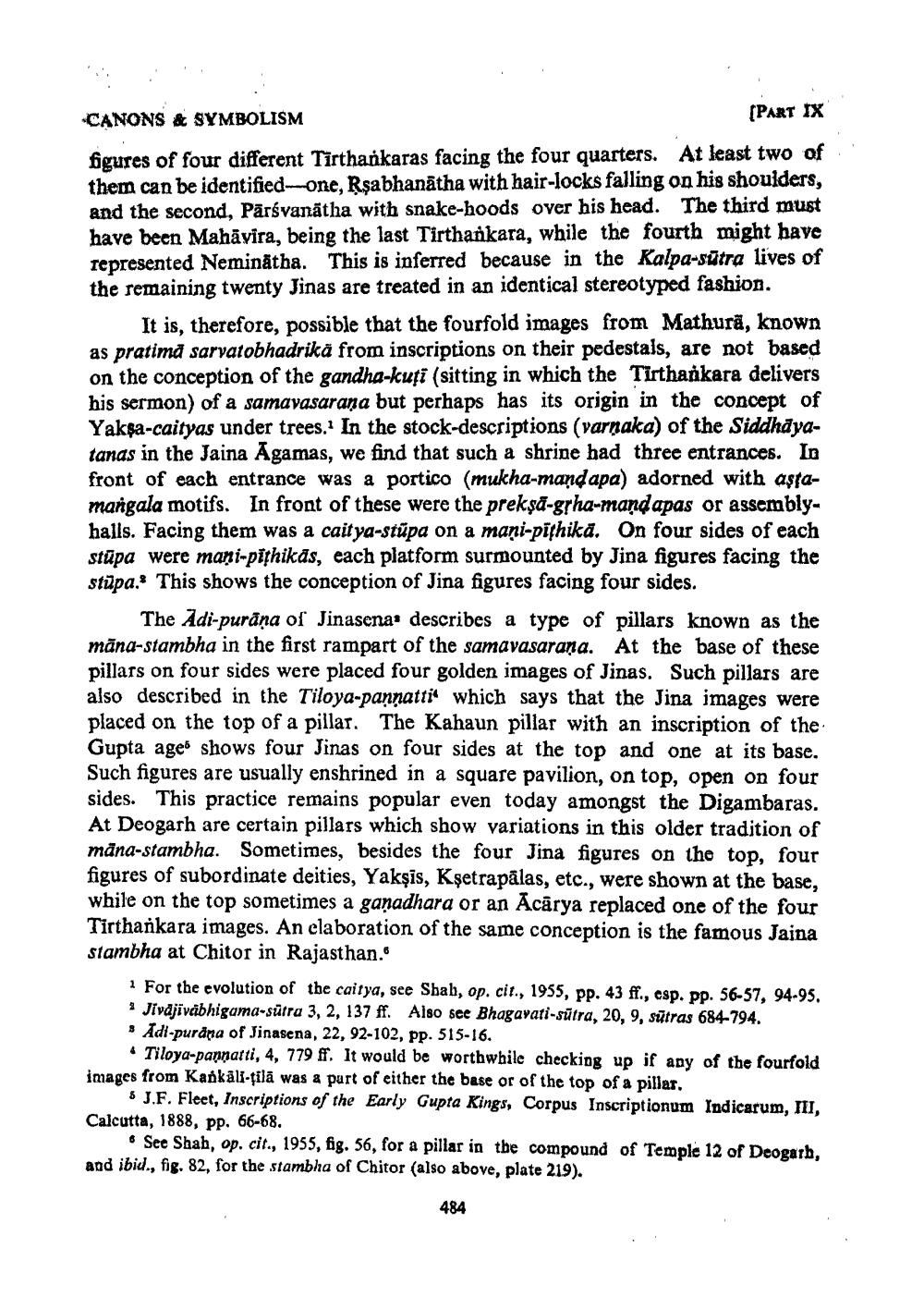________________
CANONS & SYMBOLISM
(PART IX figures of four different Tirthańkaras facing the four quarters. At least two of them can be identified-one, Rşabhanātha with hair-locks falling on his shoulders, and the second, Pārsvanātha with snake-hoods over his head. The third must have been Mahāvira, being the last Tirthankara, while the fourth might have represented Neminätha. This is inferred because in the Kalpa-sūtra lives of the remaining twenty Jinas are treated in an identical stereotyped fashion.
It is, therefore, possible that the fourfold images from Mathura, known as pratimd sarvatobhadrika from inscriptions on their pedestals, are not based on the conception of the gandha-kuți (sitting in which the Tirthankara delivers his sermon) of a samavasarana but perhaps has its origin in the concept of Yaksa-caityas under trees. In the stock-descriptions (varnaka) of the Siddhayatanas in the Jaina Agamas, we find that such a shrine had three entrances. In front of each entrance was a portico (mukha-mand apa) adorned with aştamangala motifs. In front of these were the prekşā-grha-mandapas or assemblyhalls. Facing them was a caitya-stupa on a mani-pishika. On four sides of each stūpa were mani-pithikas, each platform surmounted by Jina figures facing the stūpa. This shows the conception of Jina figures facing four sides.
The Adi-puräna of Jinasena: describes a type of pillars known as the māna-stambha in the first rampart of the samavasarana. At the base of these pillars on four sides were placed four golden images of Jinas. Such pillars are also described in the Tiloya-pannatti' which says that the Jina images were placed on the top of a pillar. The Kahaun pillar with an inscription of the Gupta ages shows four Jinas on four sides at the top and one at its base. Such figures are usually enshrined in a square pavilion, on top, open on four sides. This practice remains popular even today amongst the Digambaras. At Deogarh are certain pillars which show variations in this older tradition of māna-stambha. Sometimes, besides the four Jina figures on the top, four figures of subordinate deities, Yakşis, kşetrapālas, etc., were shown at the base, while on the top sometimes a ganadhara or an Acārya replaced one of the four Tirtharkara images. An elaboration of the same conception is the famous Jaina stambha at Chitor in Rajasthan.
1 For the evolution of the caitya, see Shah, op. cit., 1955, pp. 43 ff., esp. pp. 56-57, 94-95. ? Jivdjivabhigama-sūtra 3, 2, 137 ff. Also see Bhagavati-sūtra, 20, 9, sūtras 684-794. . Adi-purana of Jinasena, 22, 92-102, pp. 515-16.
• Tiloya-pannarti, 4, 779 ff. It would be worthwhile checking up if any of the fourfold images from Karkāli-tilā was a part of either the base or of the top of a pillar.
J.F. Fleet, Inscriptions of the Early Gupta Kings, Corpus Inscriptionum Indicarum, m, Calcutta, 1888, pp. 66-68.
. See Shah, op. cit., 1955, fig. 56, for a pillar in the compound of Temple 12 of Deogarh, and ibid., fig. 82, for the stambha of Chitor (also above, plate 219).
484




